________________
xi] Application of Dialectic to Different Categories 145 the “not-cause” of the definition without understanding what is the nature of cause, and vice-versa. Moreover, space, being a permanent substance, is always present as a not-cause of anything and is yet regarded as the cause of sound. If, again, cause is defined as that which is present when the effect is present and absent when the effect is absent, this would not explain the causality of space, which is never known to be absent. If, again, cause is defined as invariable antecedence, then permanent substances such as space are to be regarded as the sole causes of effects. If, however, invariable antecedence be understood to mean unconditional antecedence, then two coexistent entities such as the taste and the colour of an earthen pot which is being burnt must mutually be the cause of the colour and the taste of the burnt earthen pot; for neither does the colour condition taste, nor does the taste condition colour. Moreover, if mere invariable antecedents be regarded as cause, then the invariably preceding symptoms of a disease are to be regarded as the cause of the disease on account of their invariable antecedence. Again, causality cannot be regarded as a specific character or quality belonging to certain things, which quality can be directly perceived by us as existing in things. Thus we may perceive the stick of the potter's wheel to be the cause of the particular jugs produced by it, but it is not possible to perceive causality as a general quality of a stick or of any other thing. If causality existed only with reference to things in general, then it would be impossible to conceive of the production of individual things, and it would not be possible for anyone to know which particular cause would produce a particular effect. On the other hand, it is not possible to perceive by the senses that an individual thing is the cause of a number of individual effects; for until these individual effects are actually produced it is not possible to perceive them, since perception involves sense-contact as its necessary condition. It is not necessary for our present purposes to enter into all the different possible concepts of cause which Srīharsa seeks to refute: the above examination is expected to give a fairly comprehensive idea of the methods of Srīharşa's refutation of the category of cause.
Nor is it possible within the limited range of the present work to give a full account of all the different alternative defences of the various categories accepted in Nyāya philosophy, or of all the various ways in which Śrīharsa sought to refute them in his
10
DII




